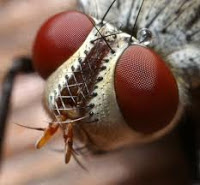The housefly, or more commonly known as fly, that we know today is a pest that humans could interact with often. They are mostly present in dirty places, mainly in areas with food waste, decaying dead organic matter, and feces, because this is the most suitable place for a fly to lay its eggs. In this manner, houseflies rapidly reproduce, and sooner than you know it, you can already see a swarm of houseflies.
That’s why some people make the effort of catching a fly upon seeing one. However, this action is easier said than done because catching a housefly is more challenging than it seems. Most of the time, when you try to hit a fly with a flyswatter, it would already have flown away even before you land your swat.
Because of this, we might come up with the question, how does a fly do it? How do the eyes of a fly work differently from ours? And, are they able to see in all directions at the same time? In this article, we’ll further look into how does the eye of a fly works.
How does a fly use its eyes?
The eyes of a fly have several different features compared to humans. And to answer our question, flies technically cannot see in all directions at the same time. Although they can indeed see in more directions at the same time than us, this doesn’t necessarily mean that they can see in all directions.
Because of this, we might come to think that flies have better vision than humans; this is a huge misconception since flies only have 20/1200 vision – unlike the standard 20/20 vision for humans.
However, due to the fly’s eye structure, it tends to see in a wider range compared to us. It explains why they can quickly react to movements and avoid getting swatted. Another thing to consider is that flies can see movements in slow motion because of its high flicker fusion rate.
What are the parts of the eye of a housefly?
Similar to other insects, a housefly has two kinds of eyes – simple and compound.
The two big round eyes that we can see on a fly is what we call the compound eyes. A male fly has its compound eyes almost touching each other, while the female fly has compound eyes that are more separated. The compound eye works like a group of eyes packed together. Each of these “eye,” also known as ommatidia, works like an individual eye, which has its photoreceptor cells, cornea, and lens. A compound eye may have more than a thousand ommatidia. Interestingly, a common housefly has more than twelve hundred ommatidia.
The numerous ommatidia found within a compound eye of a housefly enables it to be better at picking up motion, although it’s unable to focus on an image, unlike humans. Imagine each of the thousands of tiny eyes sending vision signals to the brain. Because of this, we can say that houseflies can see images in all directions above its head.
The simple eyes, on the other hand, are small photo-receptors, mainly to detect light. This little eyes, also known as ocelli, could be found between the compound eyes of a housefly. Some insects have one to three ocelli, while a common housefly has three. The ocelli cannot process images, unlike the compound eyes, but it can detect movement as well as light.
Additional reading:
- Housefly (Wikipedia)

